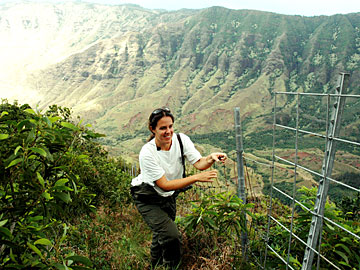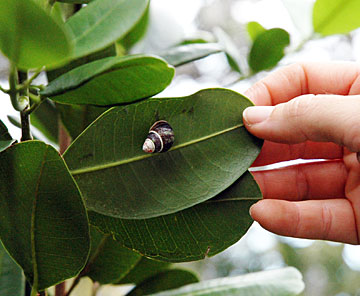
GREGG K. KAKESAKO / GKAKESAKO@STARBULLETIN.COM
Army botanist Kapua Kawelo checks the fence on Ohikilolo Ridge at the 2,800-foot elevation, where many endangered plants and animals can be found.
|
|

A native Hawaiian botanist relishes an Army job caring for rare species on a war-game range
AS A NATIVE HAWAIIAN and an Army botanist, Kapua Kawelo says she knows she walks a "difficult tightrope."
She must balance her job of taking care of endangered plants and species in Makua Valley with demands by environmentalists and Hawaiian activists that the military leave area.
"I feel torn," said Kawelo. "But also I feel good with what the Army is doing here. Besides protecting the 28 endangered plants and four species, we are providing access for cultural purposes."
Kawelo discussed her job and Makua during a media tour last week that included a visit to Ohikilolo Ridge, 2,800 feet above the valley floor. Here Army biologists have been cultivating Kahuli tree snails -- one of the four endangered species that inhabit the 4,190-acre Makua Military Reservation.
Makua Military reservation encompasses two valleys -- Kahanahaiki and Makua -- which are the northernmost major valleys on the leeward side of the Waianae Mountain.
The valley is considered sacred by many native Hawaiians who do not want the military to train there. Makua, which means parents in Hawaiian, has 20 known cultural and historic sites with another nearly 100 unidentified ones.
"I feel torn. But also I feel good with what the Army is doing here. Besides protecting the 28 endangered plants and four species, we are providing access for cultural purposes."
Kapua Kawelo
Army botanist
Kawelo acknowledges that her expertise lies in protecting the valley's native Hawaiian endangered plants and animals and not its archaeological and cultural heritage.
"But plants and animals are part of the living culture too," she said.
Kawelo said the issue is vexing, referring to an incident where a relative visited Makua. "He was so moved and saddened by the presence of the military in this valley ... I had conversations with him and I asked him to look at from my prospective -- the management and protection of the natural resources of the plants and animals."
Kawelo, who attended Punahou School, has been working in the natural resource section of the Army's Directorate of Public Works environmental division since getting her a degree in botany from University of California at Davis three years ago. Even before graduating, she worked as an intern in the valley.
She estimates that her staff of 28 people spend about 75 percent of their time tending to plants and animals that live in the rugged terrain.
With the Army committed to spend up to $3.4 million annually for the next two decades to protect the endangered species and plants in the valley, Kawelo said "biologically speaking it is more beneficial for the military to stay."
"From my perspective I hear we won't get full funding for our program if the Army is not using the valley and is forced to give it up," she said. "In some way, shape or form, I would like the Army to continue using the valley so that our programs can continue to get funding and continue doing positive things to protect our natural resources."
Since 1995 the U.S. Fish and Wildlife Service has required the Army to "stabilize" the population of endangered plants and animals found in Makua, Kawelo said.
This has been done by developing three different areas in the Waianae area where these 28 endangered plants can be cultivated. For instance, the mao hau hele -- or yellow hibiscus which is the state flower -- is grown on the northern flank of Ohikilolo Ridge.

GREGG K. KAKESAKO / GKAKESAKO@STARBULLETIN.COM
Populations of kahuli tree snails, one of four endangered animals that live in Makua Valley, have begun to thrive under the watchful eyes of Army hired civilian botanists. This snail lives 2,800 feet above the floor of Makua Valley on Ohikilolo Ridge.
|
|
Army biologists, botanists and volunteers hike the ridge line at least once a quarter spending several days there taking population censuses of the endangered plants and collecting seeds.
They also inspect the 14 miles of fences built on the narrow ridges surrounding the valley to keep out the goats and pigs that feed on the foliage in the valley. The majority of the endangered animals live on the ridge line 2,800 feet above the training range.
Kawelo noted that before the Army began building the fences in 1995, goats had stripped many of the trees on the ridge line of their leaves and branches -- habitats of the endangered tree snail.
"It was just bare from five to six feet above the ground," she said. The fencing and a goat eradication by hunters eliminated 2,500 animals over the past nine years.
The Army's helicopter tour of the Leeward Oahu training area, which the military has been using as a firing range before World War II, was held as the 25th Infantry Division leaders were awaiting for a ruling by federal Judge Susan Mollway whether soldiers can resume live-fire training in Makua to prepare 7,000 Schofield Barracks soldiers for a combat tour in Iraq.
But on Thursday Mollway ruled that the Army failed to live up to a 2001 court settlement requiring the suspension of live-fire training until it completes an environmental impact statement that was due in 2004.
The 2001 settlement was with Earthjustice, representing the native Hawaiian group Malama Makua, which contends that the Army has not taken adequate means to protect both the archaeological sites in the valley as well as the endangered plants and animals in the area.
The Army now says the EIS will be completed in March or April.
Until then the Army can train in Makua but is prohibited from using live ammunition.
Soldiers firing live ammunition from rifles and machine guns and setting off mortars have caused valley brush fires in the past. Kawelo said brush fires are a major concern.
"Shooting live ammunitions that have a higher possibility for fires bother me more than soldiers using blank ammunition," she said.
Another cause of Makua brush fires have been what the Army calls "prescribed burns," planned fires used to clear the training area of unwanted foliage to find unexploded ordnance. In July 2003, about 2,100 acres were accidentally scorched in a prescribed burn instead of the planned 500 acres.
Kawelo said the planned burns are a greater danger than the use of live ammunition in training.

